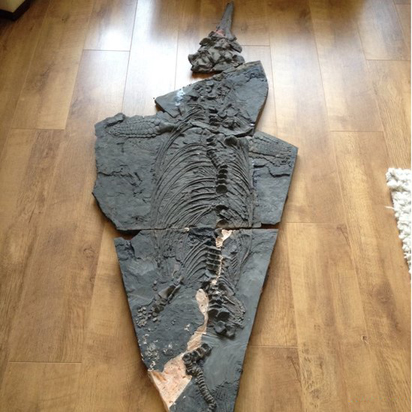Amateur Fossil Hunter Finds Welsh Ichthyosaur
The foreshore along the beaches in the Penarth area of the Vale of Glamorgan (South Wales), is one of the most popular fossil collecting locations in the whole of the British Isles. The beaches are very accessible, there is plenty of parking nearby and the sites are loved by family holiday makers. The strata in the area, is Lower Jurassic (blue lias) and it is highly fossiliferous. A thirty minute walk along the foreshore can result in the finding of many specimens, mostly brachiopods, gryphaea, and the occasional worn ammonite fragment.
Welsh Ichthyosaur Fossil Discovery
Vertebrate fossils, those of marine reptiles are rare, although the occasional ichthyosaur vertebra or paddle bone can be discovered. Geological hammers are not necessary, the strong tides combined with the the crumbly nature of the cliffs ensures a regular scattering of fossils across the beach. However, one very lucky amateur palaeontologist has uncovered the fossilised remains of a two-metre-long Ichthyosaurus, and what’s more, the specimen seems almost complete.
Beach Find
Jonathan Bow, made his discovery whilst walking along the beach back in September, a small inch long piece of rock took his eye after it had been exposed by a tide. He stated that anyone could have made this find, it all took was careful observation. Indeed, this is true, when Everything Dinosaur team members are out on fossil hunts it is often the children who are with us with their sharper eyesight, that spot the fossils.
The Fossilised Remains of the Ichthyosaur (after preparation)
Picture credit: Jonathan Bow
A Once in a Lifetime Find
Mr Bow, a keen fossil collector explained that:
“Something this large and complete is a once in a lifetime find.”
The collections manager in the Geology Department at the National Museum Wales described this fossil as “potentially a very important find.”
Ichthyosaurs were a diverse group of marine reptiles that evolved in the Early Triassic and thrived during the Jurassic Period. As a group they survived into the Cretaceous but mysteriously, despite being superbly adapted to marine environments, they became extinct around eighty million years ago.
Ichthyosaurs – Marine Reptiles Known as “Fish Lizards”

The Ichthyosaurus model (Wild Safari Prehistoric World) ready to take its turn on the Everything Dinosaur turntable. Picture credit: Everything Dinosaur.
2014 marks the 200th anniversary of the first scientific description of an animal that was later named as an ichthyosaur. In June 1814, Sir Everard Home published an account of a discovery made by the Anning family of Lyme Regis (Dorset). This was the first scientific account ever published on an ichthyosaur. Fitting then, that this year, the most complete fossilised remains of a “Fish Lizard” found in South Wales have come to light.
A Welsh Ichthyosaur Fossil
Ichthyosaurus Fossils Come to Light
Picture credit: Jonathan Bow
The picture shows a smaller Ichthyosaurus fossil specimen as Mr Bow found it (small picture, bottom left) and the larger picture shows the same specimen once it had been exposed and prepared. Ribs, paddle bones and vertebrae can be clearly distinguished.
Our congratulations to Jonathan, but a word of warning to would be fossil hunters keen to visit this part of the Welsh coast. The cliffs are dangerous and rock falls common, there are plenty of fossils to find on the beach, please avoid getting too close to the cliffs.
A spokesperson from Everything Dinosaur, acknowledged that the cliffs were best avoided and that there were plenty of fossils to be found on the beach itself, particularly along the foreshore, before adding:
“We suspect that this is an example of the ichthyosaur species called Ichthyosaurus communis, although we would need to take a closer look before a species identification could be formally made. We anticipate further marine reptile fossil finds early next Year, but this time from the Jurassic coast of Dorset as the winter storms do their work.”








Leave A Comment